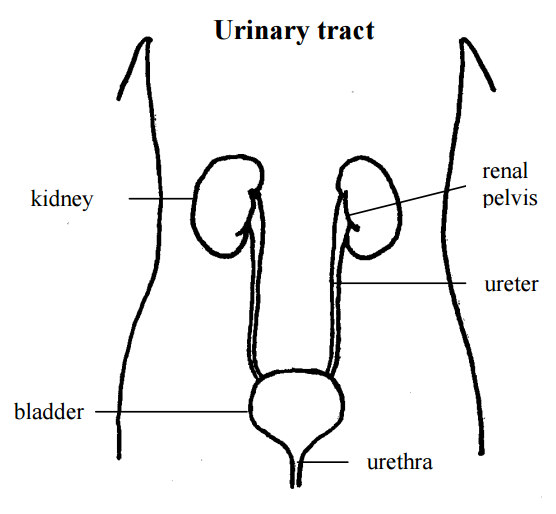Pyeloplasty
What is pyeloplasty?
Pyeloplasty is a surgery on the renal pelvis (the narrow part of the kidney) to remove a blockage where the ureters and kidneys are joined. This allows urine to drain freely from the kidneys to the bladder. If not repaired, urine can back up in the kidney and cause kidney damage.

How is it diagnosed?
Often in a prenatal ultrasound, the kidneys will show up filled with fluid. After birth, more kidney tests are done. Depending on the amount of blockage, surgery may be done early in life.
Some children do not have signs of blockage until they are older. These may include:
- nausea (upset stomach)
- vomiting (throwing up)
- stomach pain
- back pain
What can I expect after surgery?
A catheter (small tube) will be inserted through the urethra into the bladder during surgery to drain the urine. It is normal for the color of the urine to be red or pink with a few blood clots. The urine's color will gradually become clear yellow. The catheter will be removed 1 to 2 days after surgery.
Your child may also need another tube, sometimes called a stent, to drain the urine while the kidney is healing. This stent will be removed when the urine output has slowed down. This is usually done in the office 10 to 14 days after surgery.
Another tube, called a drain, may be inserted in the area around the kidney and ureter to drain extra fluid that can collect during and after surgery. After drainage has stopped, your doctor will decide when to remove it.
The anesthesiologist and surgeon will prescribe and explain the medicines that will be used to keep your child comfortable. During the surgery the surgeon will inject a medicine into the incision that will numb the area for about 6 to 8 hours.
Your child may have pain or soreness at the site of the surgery, and possibly bladder spasms. Medicine can be given to ease these discomforts. See the education sheet "Pain in children and adolescents."
If old enough, your child should practice deep breathing exercises and get out of bed and walk often to help prevent complications after surgery.
Your child will have an intravenous line (IV) to provide fluids, antibiotics, and pain medicines. The doctor will decide when the IV and IV medicines are no longer needed.
One or two monitors will be used to observe your child's heart rate and breathing patterns.
What can my child eat?
At first, your child will be allowed only sips of clear fluids. Foods are added slowly.
How should I care for my child?
Children usually go home on the second or third day after surgery. The surgeon will prescribe a pain medicine, and possibly an antibiotic to be taken until the stent is removed. The surgeon will also give you instructions about the bandage.
Encourage drinking plenty of fluids to prevent concentration of the urine and irritation of the surgical site.
How active can my child be?
Your child may return to school or day care when feeling well enough.
Encourage quiet activities. No physical activity for 2 weeks or until the stent is removed (whichever is longer).
Avoid activities such as:
- gym
- swimming
- running
- climbing toys
- bike-riding
- skating
What else do I need to know?
A kidney ultrasound will be done 4 to 6 weeks after surgery. A renogram will also be done if needed.
When should I call the surgeon?
- urinating less often than usual
- urine smells bad
- change in urine color
- increase in pain
- fever higher than 101.5 F (by mouth)
- incision looks red or swollen
- drainage from the incision
Questions?
This sheet is not specific to your child but provides general information. If you have any questions, please call the surgeon.
Children's Hospitals and Clinics of Minnesota
Patient/Family Education
2525 Chicago Avenue South
Minneapolis, MN 55404
Last reviewed 8/2015 ©Copyright
This page is not specific to your child, but provides general information on the topic above. If you have any questions, please call your clinic. For more reading material about this and other health topics, please call or visit Children's Minnesota Family Resource Center library, or visit www.childrensmn.org/educationmaterials.
© 2024 Children's Minnesota
